Introduction to Astronomy
The Jovian Planets, and Space 'Trash'
Space Rocks
The asteroids generally fall between Mars and Jupiter, although they are not uncommon inside the orbit of Mars.
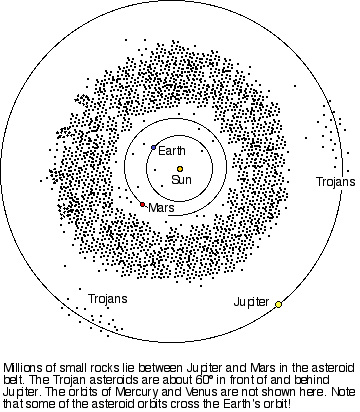 Why should YOU care about asteroids? Because sometimes they smash into us. We have lots of good evidence for this, including the Manicougan impact site,
Why should YOU care about asteroids? Because sometimes they smash into us. We have lots of good evidence for this, including the Manicougan impact site,
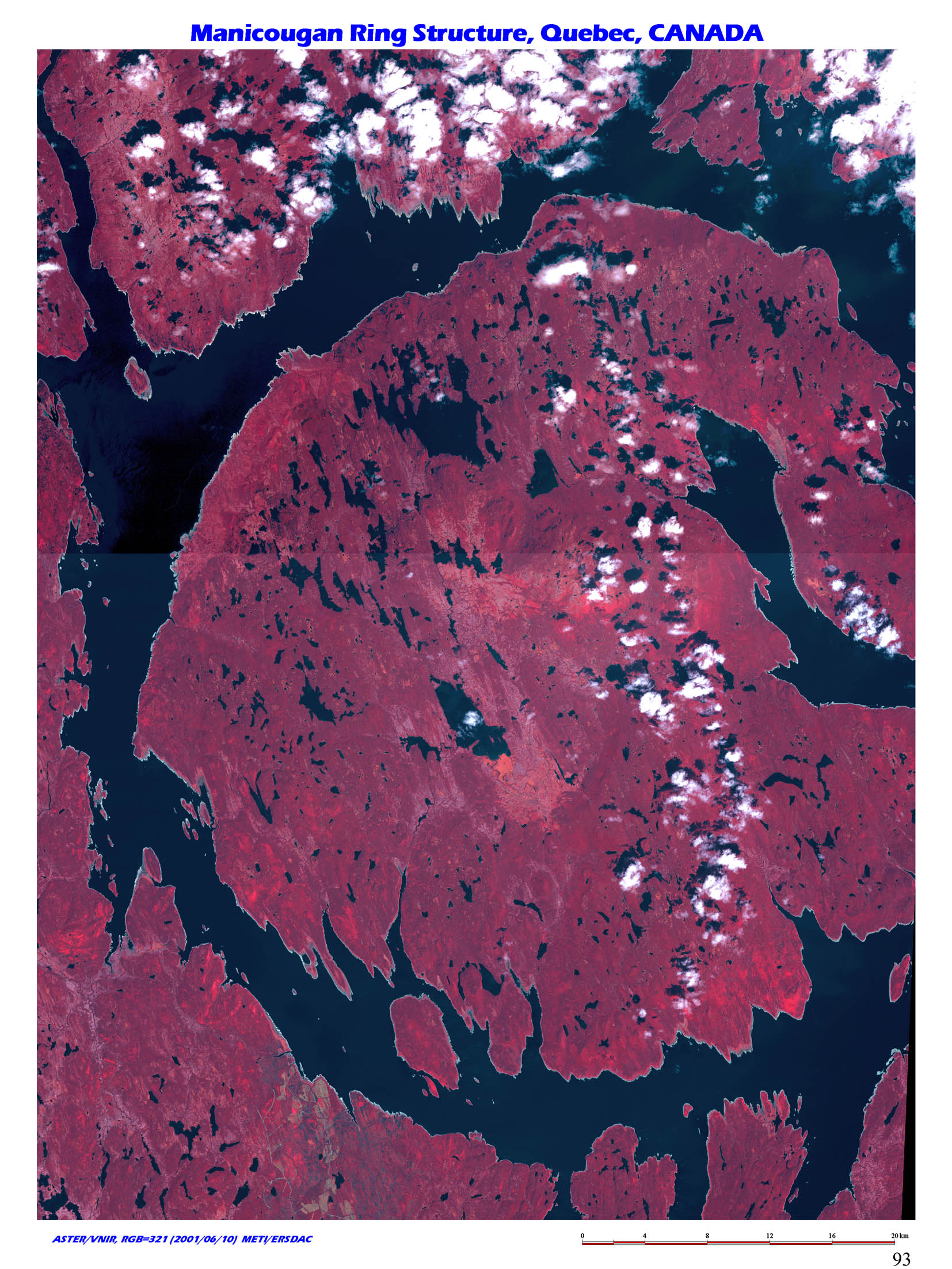 and the Chicxulb site off of the Yucatan (this was most likely the dinosaur killer...).
and the Chicxulb site off of the Yucatan (this was most likely the dinosaur killer...).
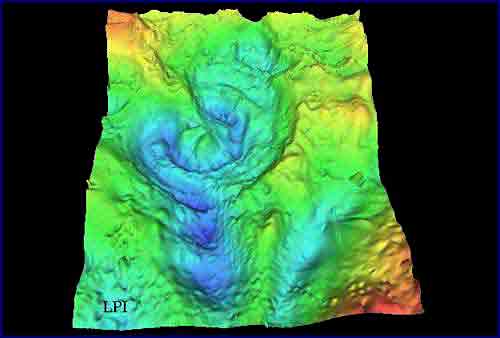 Asteroids look like potatoes. See?
Asteroids look like potatoes. See?
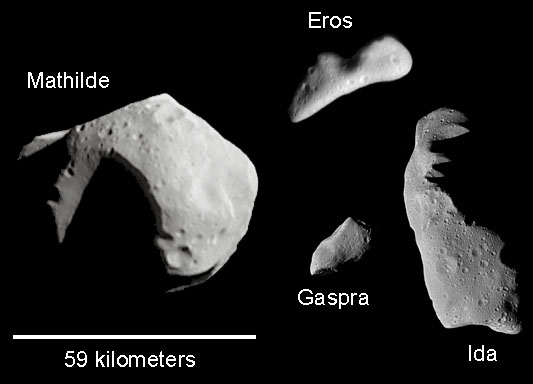 Sometimes little rocks fall on the ground, and we go around and pick them up, because we are curious. Meteorites come in three types: stony, stony-iron, and iron. Back in the day, iron and stony-iron meteorites were the main source of iron for making weapons like swords and skillets. Nowadays, we mostly dig iron out of the ground.
Most meteorites are difficult to find, because they look just like regular rocks. Here, for example, is a spectacular example of a stony meteorite:
Sometimes little rocks fall on the ground, and we go around and pick them up, because we are curious. Meteorites come in three types: stony, stony-iron, and iron. Back in the day, iron and stony-iron meteorites were the main source of iron for making weapons like swords and skillets. Nowadays, we mostly dig iron out of the ground.
Most meteorites are difficult to find, because they look just like regular rocks. Here, for example, is a spectacular example of a stony meteorite:
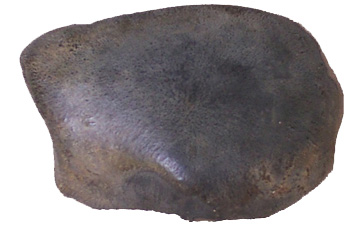 Aren't you impressed with this ACTUAL SPACE ROCK!? I thought not. The only way we find these kinds of meteorites is by flying over Antarctica in a helicopter, with some poor slob undergraduate student hanging out the side, looking for dark blobs. (No kidding! This is how it's done!) If the blob is on top of the snow, it must have gotten there recently, which means it most likely fell from the sky.
Somewhat easier to find are stony-iron meteorites, which have little blobs of iron stuck in the stone:
Aren't you impressed with this ACTUAL SPACE ROCK!? I thought not. The only way we find these kinds of meteorites is by flying over Antarctica in a helicopter, with some poor slob undergraduate student hanging out the side, looking for dark blobs. (No kidding! This is how it's done!) If the blob is on top of the snow, it must have gotten there recently, which means it most likely fell from the sky.
Somewhat easier to find are stony-iron meteorites, which have little blobs of iron stuck in the stone:
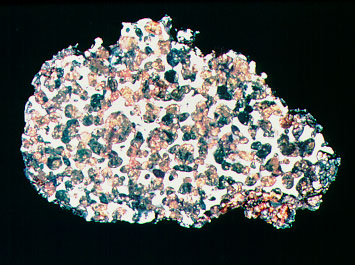 Of course, the iron is mostly on the inside...
Finally, there are the iron meteorites, which are nearly pure iron. These are exceptionally heavy for their size.
Of course, the iron is mostly on the inside...
Finally, there are the iron meteorites, which are nearly pure iron. These are exceptionally heavy for their size.
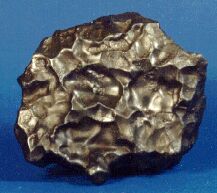 99 times out of a hundred, a person who thinks they have a meteorite has a regular Earth rock. Sad, but true.
99 times out of a hundred, a person who thinks they have a meteorite has a regular Earth rock. Sad, but true.
Jupiter
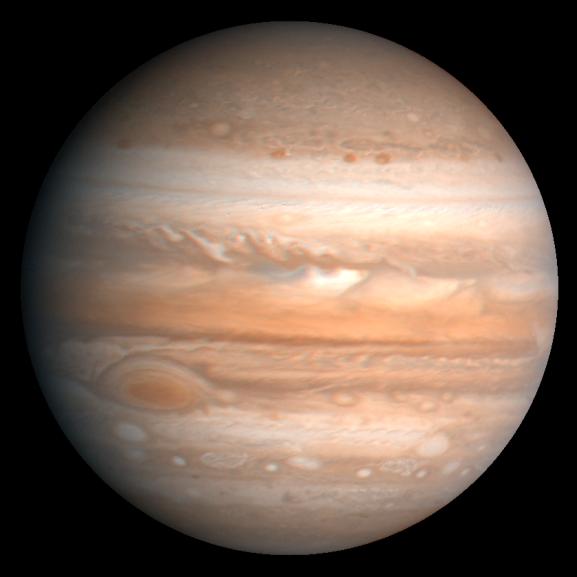 Jupiter is the largest planet in the solar system. If you divided the mass of the solar system in 100 parts, The Sun would be 99 of them, Jupiter would be 1, and you wouldn't even bother with everything else! Jupiter is a 'gas giant', meaning that the vast majority of the planet is atmosphere, rather than being mostly rocky, like Earth or Mars. Jupiter played a critical role in the formation of the solar system, stabilizing the disk from which the planets formed.
Jupiter is the largest planet in the solar system. If you divided the mass of the solar system in 100 parts, The Sun would be 99 of them, Jupiter would be 1, and you wouldn't even bother with everything else! Jupiter is a 'gas giant', meaning that the vast majority of the planet is atmosphere, rather than being mostly rocky, like Earth or Mars. Jupiter played a critical role in the formation of the solar system, stabilizing the disk from which the planets formed.
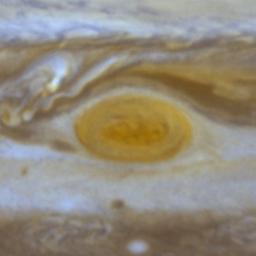 The Great Red Spot on Jupiter is probably its most famous feature. It is actually a hurricane, that has been blowing on Jupiter ever since Galileo first used a telescope to look at Jupiter. To put it in perspective, the Earth would fit inside the spot twice.
The Great Red Spot on Jupiter is probably its most famous feature. It is actually a hurricane, that has been blowing on Jupiter ever since Galileo first used a telescope to look at Jupiter. To put it in perspective, the Earth would fit inside the spot twice.
 The black dot in the above image is a shadow of one of Jupiter's moons. Can you find the moon? Jupiter has many moons (the number grows periodically as we discover new rocks in orbit around Jupiter---last time I looked, there were 63!). Four of these moons are 'important'. They are the four largest, called the Galilean moons, since they were discovered by Galileo, and used by him to help show that the Earth was probably NOT the center of everything.
The black dot in the above image is a shadow of one of Jupiter's moons. Can you find the moon? Jupiter has many moons (the number grows periodically as we discover new rocks in orbit around Jupiter---last time I looked, there were 63!). Four of these moons are 'important'. They are the four largest, called the Galilean moons, since they were discovered by Galileo, and used by him to help show that the Earth was probably NOT the center of everything.
Io
Io is cool because it has volcanoes. The center of Io is heated up by Jupiter's gravity pulling and tugging on the poor little moon (much like when you tug and stretch a bit of silly putty). While we now accept this as a matter of course, the discovery of volcanoes on Io was a surprise to most astronomers, who thought it was too far from the Sun to have remained geologically active. Here's a great picture of a volcano just at the edge of the Moon:

Europa
Europa... has a liquid salt water ocean!!!! Is that not the coolest thing you've ever heard? No? Let me explain. Life needs liquid water, right? Life seems to have developed in the salt water ocean on Earth, right? Life is found even deep below the water, near the deep sea vents, where sunlight never penetrates, right? Hooray! Europa might be a good place to look for life. In fact, after Mars, it's probably the best place to look in the solar system (and it only comes after Mars because it's so much farther away).
How do we know that Europa has a liquid salt water ocean? Well, we have evidence from spacecraft that have orbited Europa, measuring its electrical and gravitational properties. Also, Europa just looks like an ice-shrouded ocean. Here's what I mean:
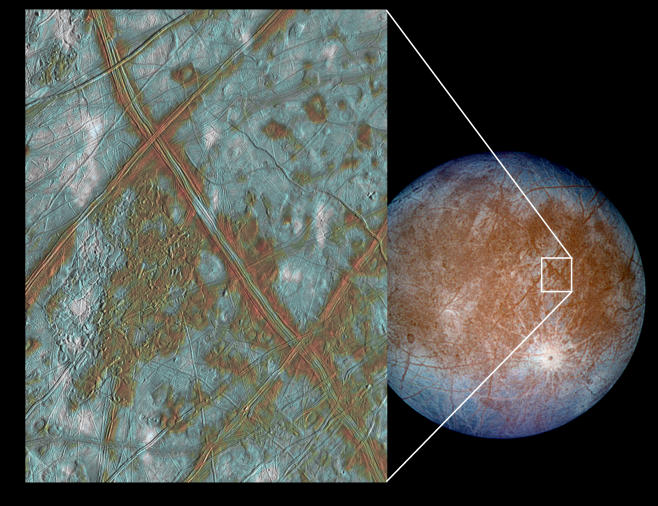 The cracks in this picture look much like the cracks that we observe in Arctic ice, only somewhat larger.
And often the Arctic ice breaks up into rafts or 'floes', that get jumbled up when packed tightly together, much like these features on Europa:
The cracks in this picture look much like the cracks that we observe in Arctic ice, only somewhat larger.
And often the Arctic ice breaks up into rafts or 'floes', that get jumbled up when packed tightly together, much like these features on Europa:
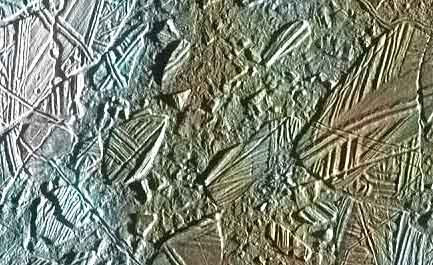 Pretty much every NASA mission that hopes to get funded these days has to include a stop at Europa. Because we would really like to know if life is common, or rare.
Pretty much every NASA mission that hopes to get funded these days has to include a stop at Europa. Because we would really like to know if life is common, or rare.
Ganymede and Callisto
Ganymede and Callisto are the other two Galilean moons. They are fundamentally big rocks, like Mercury, that have been pummeled into submission and uninteresting-ness...
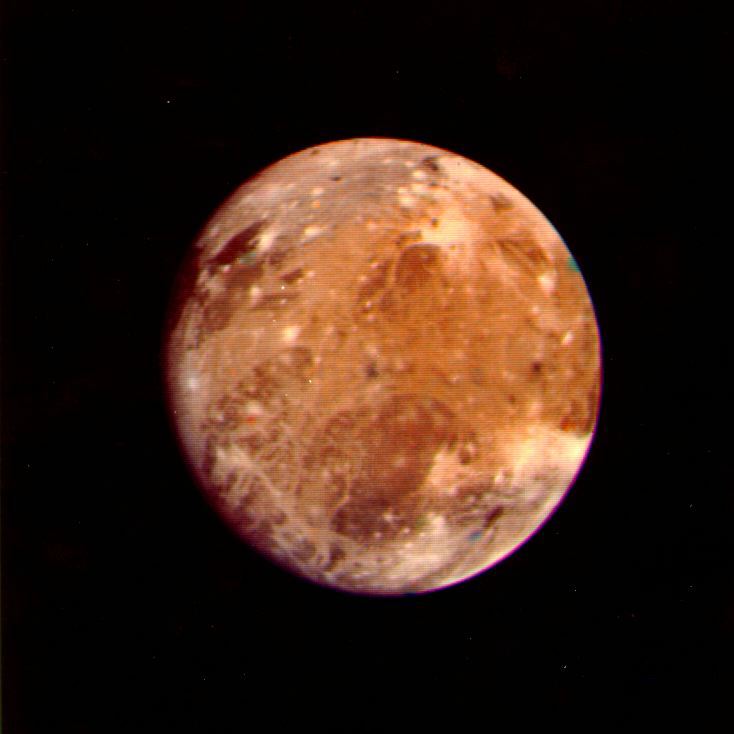
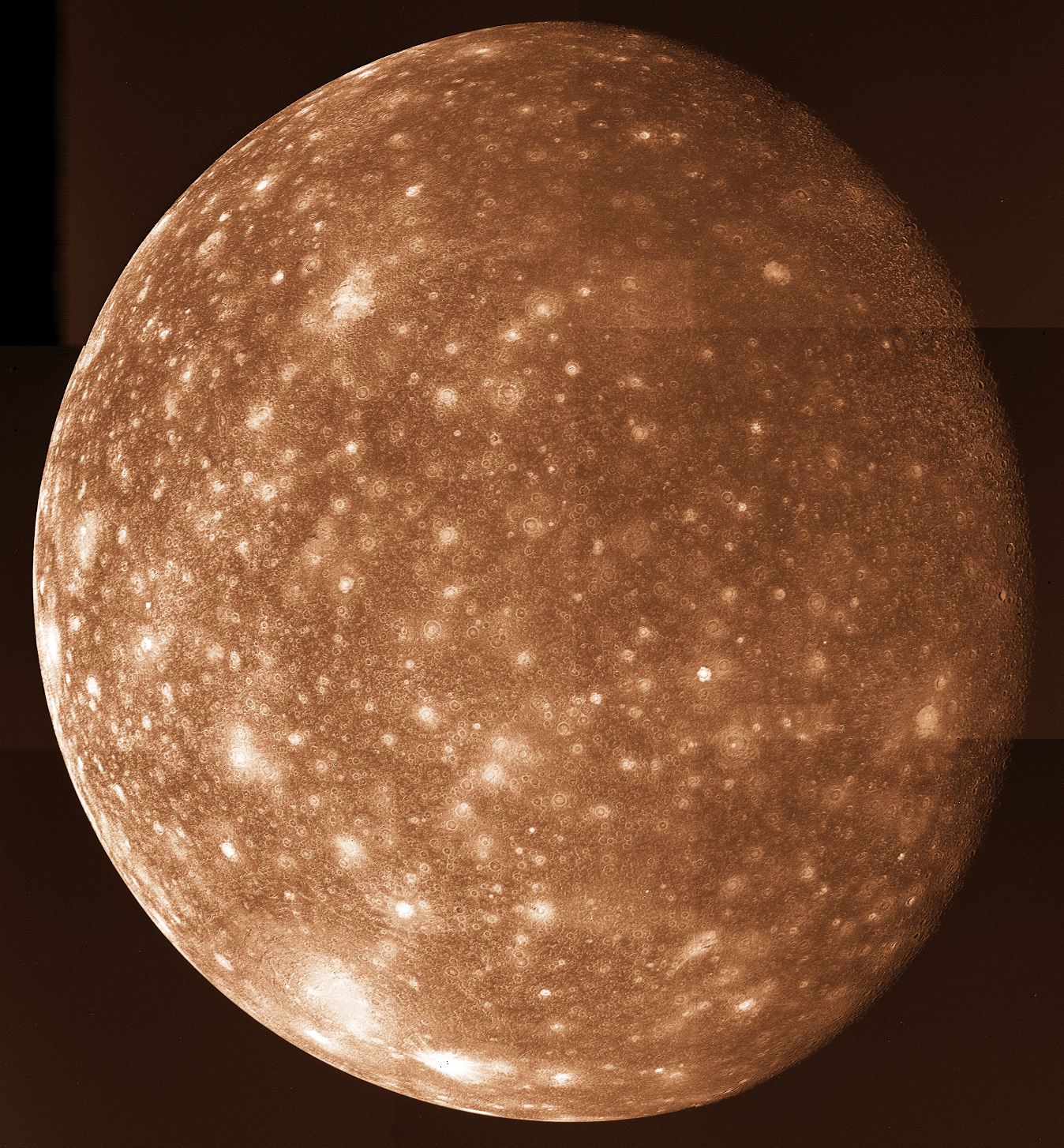
Saturn
is fundamentally just a REALLY PRETTY planet.
 I mean really. Look at that. It's beautiful.
Those rings that you see are very thin. Not long ago, the Earth and Saturn lined up just right so that we saw the rings edge on. Of course, we used Hubble Space Telescope to take a look!
I mean really. Look at that. It's beautiful.
Those rings that you see are very thin. Not long ago, the Earth and Saturn lined up just right so that we saw the rings edge on. Of course, we used Hubble Space Telescope to take a look!
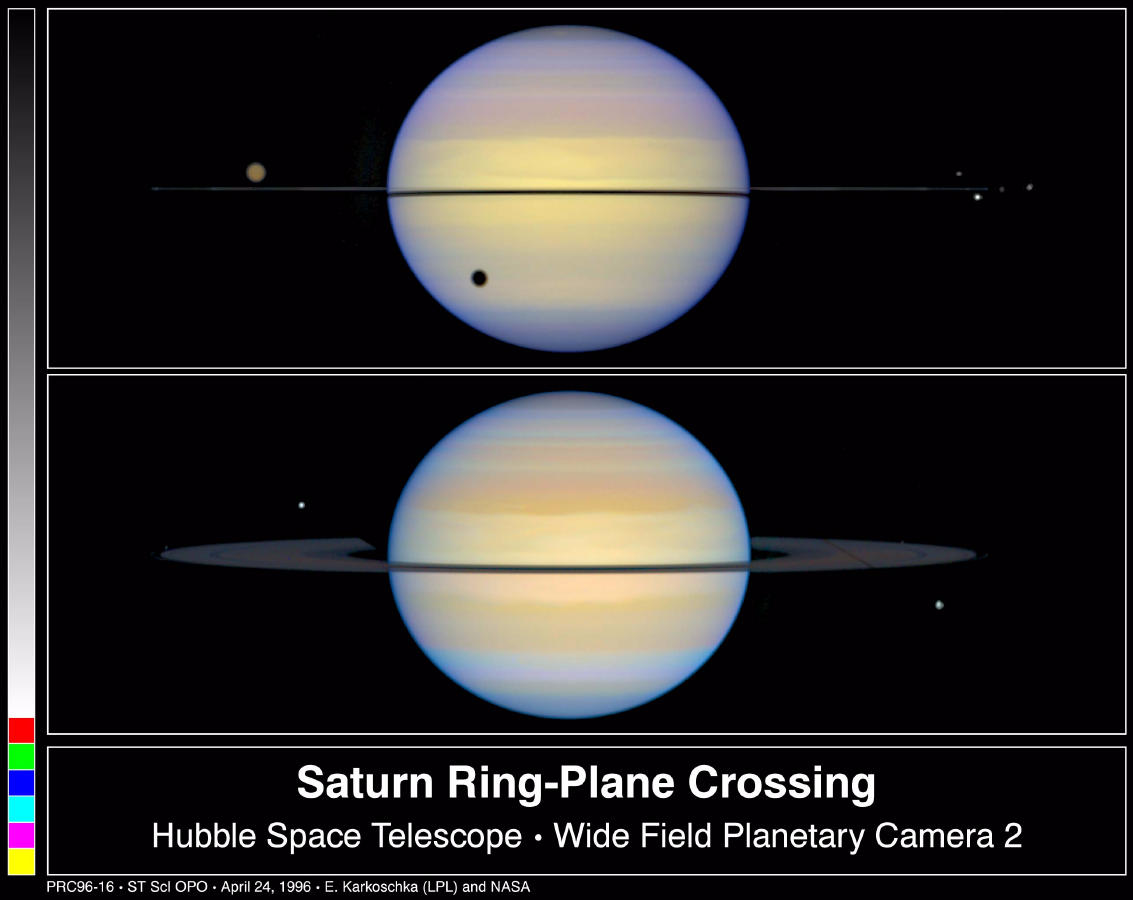 The rings are made of dust---most likely the remnants of recently pulverized moons. This close-up taken by Voyager 2 helps to show that:
The rings are made of dust---most likely the remnants of recently pulverized moons. This close-up taken by Voyager 2 helps to show that:
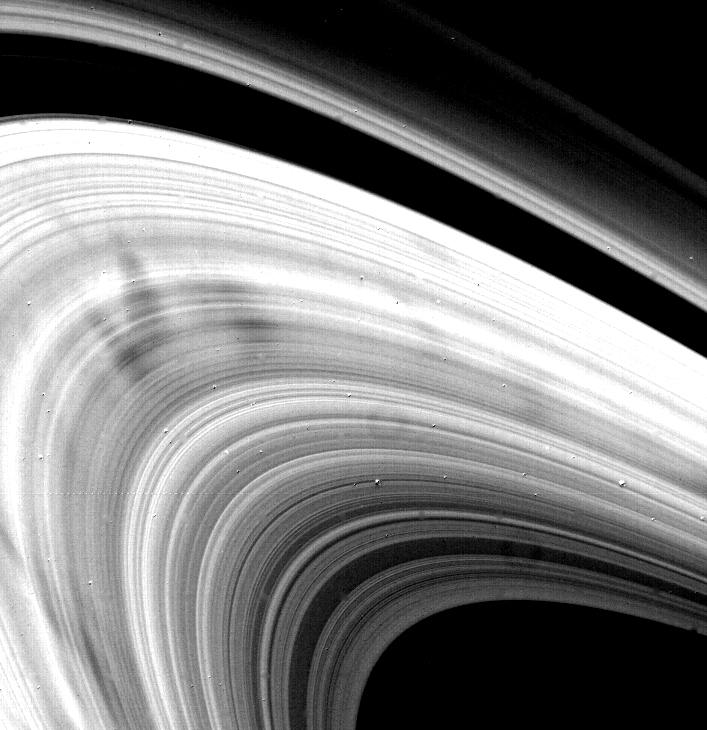
Titan
Saturn has a moon (one of many) called Titan. We've never seen the surface of this moon directly because it has a quite thick atmosphere, composed mainly of nitrogen, like the Earth's. The picture below shows a Hubble Space Telescope image, taken in the infrared, of the surface of Titan. As you can tell, we might wish for a better view! In 2004, Cassini arrived at Saturn, and dropped a probe onto Titan! You can find out what they found at this website: Cassini-Huygens Mission to Saturn and Titan Titan's atmosphere also has a significant amount of methane, which makes astronomers cautiously optimistic that there might be life there. Unfortunately, no Titanic cows have been detected yet. But there DO seem to be lakes, which is exciting. Especially if you consider they are made of liquid methane.
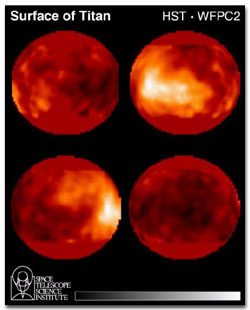 We are now building a 'map' of the surface of Titan.
We are now building a 'map' of the surface of Titan.
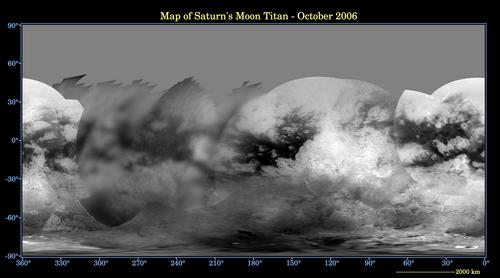
Uranus
Sadly, Voyager flew past Uranus in one of the most boring times of Uranus' year, so Uranus has a bad rap as a boring planet. Still, it's really an aficionado's planet---if you love planets, you'll love Uranus!

Neptune
Neptune is my personal favorite in the beautiful planet department...

Pluto
Poor Pluto is neglected, but everybody loves it. Best picture EVER of Pluto:
 Our last chance to get a good look at Pluto is about to pass us by! Write your congress-person!
Our last chance to get a good look at Pluto is about to pass us by! Write your congress-person!














































 Why should YOU care about asteroids? Because sometimes they smash into us. We have lots of good evidence for this, including the Manicougan impact site,
Why should YOU care about asteroids? Because sometimes they smash into us. We have lots of good evidence for this, including the Manicougan impact site,
 and the Chicxulb site off of the Yucatan (this was most likely the dinosaur killer...).
and the Chicxulb site off of the Yucatan (this was most likely the dinosaur killer...).
 Asteroids look like potatoes. See?
Asteroids look like potatoes. See?
 Sometimes little rocks fall on the ground, and we go around and pick them up, because we are curious. Meteorites come in three types: stony, stony-iron, and iron. Back in the day, iron and stony-iron meteorites were the main source of iron for making weapons like swords and skillets. Nowadays, we mostly dig iron out of the ground.
Most meteorites are difficult to find, because they look just like regular rocks. Here, for example, is a spectacular example of a stony meteorite:
Sometimes little rocks fall on the ground, and we go around and pick them up, because we are curious. Meteorites come in three types: stony, stony-iron, and iron. Back in the day, iron and stony-iron meteorites were the main source of iron for making weapons like swords and skillets. Nowadays, we mostly dig iron out of the ground.
Most meteorites are difficult to find, because they look just like regular rocks. Here, for example, is a spectacular example of a stony meteorite:
 Aren't you impressed with this ACTUAL SPACE ROCK!? I thought not. The only way we find these kinds of meteorites is by flying over Antarctica in a helicopter, with some poor slob undergraduate student hanging out the side, looking for dark blobs. (No kidding! This is how it's done!) If the blob is on top of the snow, it must have gotten there recently, which means it most likely fell from the sky.
Somewhat easier to find are stony-iron meteorites, which have little blobs of iron stuck in the stone:
Aren't you impressed with this ACTUAL SPACE ROCK!? I thought not. The only way we find these kinds of meteorites is by flying over Antarctica in a helicopter, with some poor slob undergraduate student hanging out the side, looking for dark blobs. (No kidding! This is how it's done!) If the blob is on top of the snow, it must have gotten there recently, which means it most likely fell from the sky.
Somewhat easier to find are stony-iron meteorites, which have little blobs of iron stuck in the stone:
 Of course, the iron is mostly on the inside...
Finally, there are the iron meteorites, which are nearly pure iron. These are exceptionally heavy for their size.
Of course, the iron is mostly on the inside...
Finally, there are the iron meteorites, which are nearly pure iron. These are exceptionally heavy for their size.
 99 times out of a hundred, a person who thinks they have a meteorite has a regular Earth rock. Sad, but true.
99 times out of a hundred, a person who thinks they have a meteorite has a regular Earth rock. Sad, but true.
 Jupiter is the largest planet in the solar system. If you divided the mass of the solar system in 100 parts, The Sun would be 99 of them, Jupiter would be 1, and you wouldn't even bother with everything else! Jupiter is a 'gas giant', meaning that the vast majority of the planet is atmosphere, rather than being mostly rocky, like Earth or Mars. Jupiter played a critical role in the formation of the solar system, stabilizing the disk from which the planets formed.
Jupiter is the largest planet in the solar system. If you divided the mass of the solar system in 100 parts, The Sun would be 99 of them, Jupiter would be 1, and you wouldn't even bother with everything else! Jupiter is a 'gas giant', meaning that the vast majority of the planet is atmosphere, rather than being mostly rocky, like Earth or Mars. Jupiter played a critical role in the formation of the solar system, stabilizing the disk from which the planets formed.
 The Great Red Spot on Jupiter is probably its most famous feature. It is actually a hurricane, that has been blowing on Jupiter ever since Galileo first used a telescope to look at Jupiter. To put it in perspective, the Earth would fit inside the spot twice.
The Great Red Spot on Jupiter is probably its most famous feature. It is actually a hurricane, that has been blowing on Jupiter ever since Galileo first used a telescope to look at Jupiter. To put it in perspective, the Earth would fit inside the spot twice.
 The black dot in the above image is a shadow of one of Jupiter's moons. Can you find the moon? Jupiter has many moons (the number grows periodically as we discover new rocks in orbit around Jupiter---last time I looked, there were 63!). Four of these moons are 'important'. They are the four largest, called the Galilean moons, since they were discovered by Galileo, and used by him to help show that the Earth was probably NOT the center of everything.
The black dot in the above image is a shadow of one of Jupiter's moons. Can you find the moon? Jupiter has many moons (the number grows periodically as we discover new rocks in orbit around Jupiter---last time I looked, there were 63!). Four of these moons are 'important'. They are the four largest, called the Galilean moons, since they were discovered by Galileo, and used by him to help show that the Earth was probably NOT the center of everything.

 The cracks in this picture look much like the cracks that we observe in Arctic ice, only somewhat larger.
And often the Arctic ice breaks up into rafts or 'floes', that get jumbled up when packed tightly together, much like these features on Europa:
The cracks in this picture look much like the cracks that we observe in Arctic ice, only somewhat larger.
And often the Arctic ice breaks up into rafts or 'floes', that get jumbled up when packed tightly together, much like these features on Europa:
 Pretty much every NASA mission that hopes to get funded these days has to include a stop at Europa. Because we would really like to know if life is common, or rare.
Pretty much every NASA mission that hopes to get funded these days has to include a stop at Europa. Because we would really like to know if life is common, or rare.


 I mean really. Look at that. It's beautiful.
Those rings that you see are very thin. Not long ago, the Earth and Saturn lined up just right so that we saw the rings edge on. Of course, we used Hubble Space Telescope to take a look!
I mean really. Look at that. It's beautiful.
Those rings that you see are very thin. Not long ago, the Earth and Saturn lined up just right so that we saw the rings edge on. Of course, we used Hubble Space Telescope to take a look!
 The rings are made of dust---most likely the remnants of recently pulverized moons. This close-up taken by Voyager 2 helps to show that:
The rings are made of dust---most likely the remnants of recently pulverized moons. This close-up taken by Voyager 2 helps to show that:

 We are now building a 'map' of the surface of Titan.
We are now building a 'map' of the surface of Titan.



 Our last chance to get a good look at Pluto is about to pass us by! Write your congress-person!
Our last chance to get a good look at Pluto is about to pass us by! Write your congress-person!